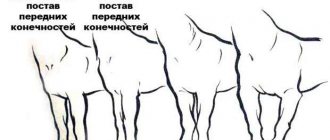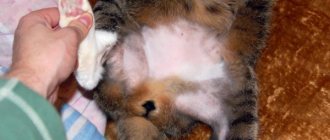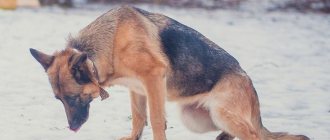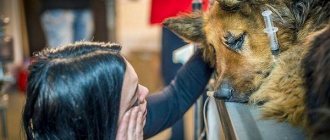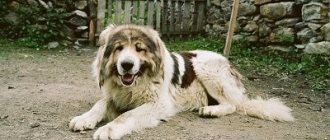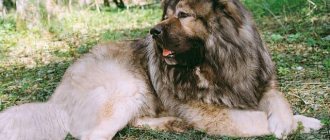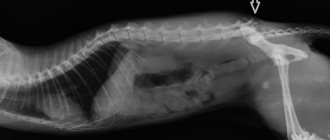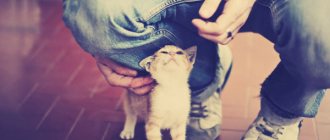German Shepherds are one of the smartest and most loyal dogs in the world, delighting their owners with energy and endless love of life throughout their lives.
However, before purchasing a puppy, you should find out about the health characteristics of representatives of this breed.
In particular, their hind legs often fail.
And in this situation, you need to know how to help your pet.
What problems can your pet encounter?
Chronic musculoskeletal problems
Chronic diseases of the musculoskeletal system include:
- dysplasia of the hip or elbow joint - most often a genetic pathology associated with abnormal development of the joint;
- knee dysplasia is a congenital joint disease in which malformations lead to damage to bone and cartilage and, as a consequence, osteoarthritis;
- panosteitis (pano) is a pathology called “wandering lameness” and is characteristic of puppies 5-12 months old.
It is also possible to develop arthrosis and arthritis.
Unpleasant odor from the ears
Most often, the fact that a dog's ears stink is due to poor diet or food allergies..
The reactions occurring in the body seriously disrupt the normal microflora inside the ear, as a result of which fungal bacteria begin to multiply. In this case, the animal's ears become itchy and red. Treat with antihistamines.
The second reason is parasites, or rather ear mites . Treated with medications and antiallergic agents.
The third reason is otitis media, which occurs when water or foreign objects get into the ear. Treated with special antibiotics.
Reasons for refusal
Impaired performance of the musculoskeletal system of German Shepherds can be caused by various diseases.
Dysplasia
A chronic pathology in which destruction of joints, ruptures of bone tissue and cartilage occurs.
If we are talking about an acquired disease, then it develops as a result of improper diet , obesity , deficiency or excess of vitamins and minerals, as well as due to serious physical activity in the puppy.
In cases where the disease is hereditary, animals have congenital abnormalities in the structure of the joints.
NOTE!
Symptoms appear only when the puppy reaches six months of age.
A sign of dysplasia is a hunchback instead of a smooth line.
Spinal diseases
As a result of bruises, as well as with discopathy, spondylosis, spondyloarthrosis and osteochondrosis, the fibrous rings are damaged, swelling and compression of the spinal cord and peripheral nerves are observed.
All this leads to the death of cells of the nervous system, which manifests itself in weakness of the limbs: from lameness to complete failure..
In some cases, spinal injuries can cause complete paralysis of the hind legs.
Oncology
Malignant or benign neoplasms on the brain or spinal cord, paws or spine can also cause malfunctions of the musculoskeletal system - tumors put pressure on the tissues and structure of the central nervous system.
There is a possibility of finding small swellings on the paws of older German Shepherds, and the dog may be limping and dragging its limbs.
If the tumors are localized in the spinal cord or brain, the German Shepherd experiences severe pain and paresis or complete paralysis of the limbs is noted.
Injuries
Injuries to the limbs, head, or spine sustained by a German Shepherd during play, fighting, walking, or an accident are another possible cause of hind leg failure.
In addition, any awkward movement, jump or fall of the dog can lead to a fracture, sprain, ruptured tendon or pinched nerve..
Expert opinion
Kozhevin Semyon Kirillovich
Expert dog handler.
German Shepherds are prone to developing diseases associated with the musculoskeletal system, therefore, first of all, they need a set of preventive measures to avoid limb failure. However, this can often be the result of a hereditary disease, when it is impossible to avoid the consequences. At the first signs of limb failure, you should immediately contact a veterinarian - only a specialist can carry out the necessary diagnostics and prescribe treatment. Remember - self-treatment will most likely be incorrect and can lead to death.
Health problems in puppies
Osteochondrosis
The main reasons for the development of osteochondrosis are:
- injuries;
- excess weight;
- hypothermia;
- excess calcium in the diet;
- rapid weight gain of the puppy with poor bone development;
- increased physical activity.
Problems with the hind legs of German Shepherd puppies appear as early as 3-6 months. He doesn't rearrange them, but drags them. The front legs are quite massive, so all the weight falls on them and on the chest. The puppy develops a broad chest.
NOTE!
Due to excessive loads on the front limbs, the dog is always with the elbows turned to the sides, and the hind limbs are straightened. The spine is modified and counted, kyphosis appears. In the hind limbs, the muscles atrophy due to their practical inactivity.
Knee dislocation is often diagnosed. The first signs can be seen in puppies that have just learned to walk. They have a noticeable unnatural gait and sometimes lameness.
In the early stages, the dog is treated with analgesics and put on a special diet.
Umbilical hernia
The birth of an animal is accompanied by the closure of the abdominal opening, to which the umbilical cord was previously attached. Usually the umbilical ring closes completely within 24 hours. The skin on the abdomen becomes smooth. But sometimes a deviation occurs, manifested in an increase in the size of the ring or a change in its shape.
The result is stretching of the connective tissue and organ prolapse. This defect may disappear after a few days, or may become a prerequisite for infringement of internal organs.
The main causes of an umbilical hernia in a puppy are:
- heredity;
- low tone of the abdominal wall;
- improper removal of the umbilical cord;
- flatulence;
- increased intra-abdominal pressure.
An umbilical hernia can be easily reduced, but the method only works in puppyhood. For adult dogs - an operation that is combined with sterilization or other planned interventions.
Rickets
The causes of rickets can be a lack of calcium, phosphorus, and vitamin D. Treatment should be comprehensive and prescribed by a veterinarian.
Symptoms of pathology
The fact that a German Shepherd's limbs are failing can be judged by the following symptoms::
- the dog squats on its paws, limps, while moving, the limbs remain straight and do not bend at the joints;
- the pet whines and squeals during movement due to severe pain;
- rapid breathing and convulsions are observed;
- swelling forms on the paws in the area of the joints;
- the animal prefers to lead a recumbent lifestyle or, on the contrary, behaves restlessly;
- in some cases, the German Shepherd cannot stand on its paws and drags them behind itself when moving;
- It is possible that aggression may occur when the owner or doctor tries to examine the hind legs or simply touch the back.
The earlier the pathology is diagnosed, the higher the chances of a positive outcome of therapy, so it is important for the owner to know about the symptoms of the disease.
White discharge in bitches
The reasons why white discharge appears in a German Shepherd can be:
- vaginitis;
- pyometra;
- endometritis;
- some inflammatory processes.
IMPORTANT!
These diseases are very difficult to treat, and it is better to use prevention than treatment.
Also read about how German Shepherds go into heat.
Harbingers of paw failure
The first signs of limb failure can vary depending on the cause.
So, with dysplasia, you need to pay attention to:
- lameness;
- instability of the paws and, as a result, an unsteady gait;
- fatigue;
- heavy lifting from a lying position;
- audible cracking of joints.
In case of injury, the damaged area swells, hematomas form, the dog experiences pain and whines, squeezing its paw.
CAREFULLY!
With pathologies of the spine, the dog shuffles and limps, and over time the limbs fail completely.
Under no circumstances should changes in the dog’s behavior or mood be ignored - even seemingly insignificant moments may turn out to be the first signs of a serious pathology.
Symptoms may appear gradually, replacing or complementing each other, or appear suddenly.
Genetic diseases
Genetic diseases occur due to recessive genes.
Cryptorchidism
With a lack of the hormone testosterone, male dogs develop cryptorchidism. They lose their ability to reproduce.
If the dog had a show career or was used for breeding, he will be castrated.
In other cases, operations are performed that correspond to the causes of the disease. After operations, male dogs can again take part in mating, but most often this is prevented so as not to spread the disease.
Hip dysplasia
Most often, the disease manifests itself in a severe form and the animal cannot perform its official tasks.
A dog with this disease stands very unsteadily on its hind legs. The steps are different from normal ones. They are too wide or, on the contrary, narrow. The animal experiences pain and, to avoid it, transfers its body weight to the forelimbs.
Why are people rejected at puppy age?
Weak joints and muscles are a feature of the physiology of German Shepherd puppies.
Often between the ages of 3 months and 5 months they may notice :
- lameness;
- falling on your hind legs or pulling them up when walking;
- X-shaped paw set;
- squatting on limbs.
If any of these manifestations of weakness of the limbs and muscles occur, it is necessary to take your pet to a veterinarian..
Based on the results of the examination and tests, the doctor will prescribe medications and make recommendations regarding a diet and training that will help build and shape the muscle corset and strengthen the musculoskeletal system.
If limb failure is the result of joint or central nervous system pathology, the success of the therapy depends on how quickly the correct diagnosis is made.
Why does a German Shepherd puppy lose his hind legs?
A physiological feature of the growing body of a German Shepherd puppy is the weakness of the joints and muscle mass necessary to support the grown skeleton. Puppies 3-5 months old may experience:
- X-shaped position of the limbs;
- squatting on one or 2 limbs;
- lameness;
- sometimes the dog falls or pulls its hind legs.
The X-shaped position of the hind legs in a puppy BUT indicates weakness of the joints and muscles
. If a German Shepherd puppy has weak hind legs, you need to contact a veterinary clinic for advice. For physiological weakness of the limbs, the specialist recommends medications, nutrition and training regimens to form muscle muscles and strengthen the animal’s musculoskeletal system. If the cause of limb failure is pathology of the joints or the central nervous system, then the success of treatment and the outcome of the disease depends on the timeliness of the pet owner contacting a specialist and the correctness of the prescription of therapeutic measures for the corresponding disease.
Diagnostic methods
Making a diagnosis includes a set of the following measures::
- general examination;
- taking anamnesis;
- laboratory tests of blood, urine;
- Ultrasound and X-ray;
- MRI and CT using contrast agent;
- checking reflexes and paw sensitivity.
Depending on the results of the examination, a diagnosis is made and drug treatment is prescribed or a decision is made on the need for surgical intervention.
How to avoid problems for a puppy
To strengthen your puppy’s muscles and ligaments, you should follow these recommendations::
- before the dog turns 1.5 years old, it is necessary to give it cottage cheese and other fermented milk products, as well as vitamins and nutritional supplements containing calcium, but strictly in the dosage recommended by the veterinarian;
- supplement the puppy’s diet with preparations containing glucosamine and chondroitin;
- observe the feeding regime and the principles of a balanced diet;
- provide your pet with moderate physical activity that promotes the formation and strengthening of the muscles of the limbs;
- eliminate the possibility of overfeeding the dog, leading to obesity and increasing the load on weak paw muscles.
It is also important to ensure that the place where the puppy plays has a smooth, non-slip surface and is free from drafts..
Problems with the gastrointestinal tract
Diarrhea
The causes of diarrhea in German Shepherds are most often poor nutrition , switching from regular food to cooked food, or spoiled food.
IMPORTANT!
It can also be hepatitis, plague and other viral diseases.
Worms, lack of vitamins, disturbed intestinal microflora, expired vaccine during vaccination, poisoning, dirty water and food (or feces of other dogs) from asphalt can also be causes of diarrhea.
The main symptom is loose stools.
Treatment requires dietary adjustments. Lack of food on the first day, water and special herbal infusions, weak tea. Rehydration and absorbent preparations. For example, 1 tablet of activated carbon per 10 kg of animal weight.
In the following days, they give easily digestible food and fermented milk products. Only if there are no signs of diarrhea do they switch to their usual diet.
Vomit
Symptoms:
- the dog often licks its muzzle and swallows saliva, which begins to be produced in larger quantities;
- the animal walks staggering, refuses food and drink;
- The pet's stomach growls loudly.
Causes:
- poisoning;
- foreign body in the digestive tract;
- intestinal obstruction;
- worms;
- stress;
- infection;
- heat or sunstroke;
- inflammation of the digestive organs;
- damage to the central nervous system;
- renal failure.
Treatment depends on the veterinary diagnosis. Infectious disease - antibiotics, antivirals. Inflammatory processes - a course of antibiotics and vitamins. Intestinal obstruction - surgical intervention. Poisoning - exclusion of food for a day, water, food as in the treatment of diarrhea.
Constipation
Symptoms:
- the dog goes to the toilet less than twice a day or does not go at all;
- the pet refuses food and drinks a lot of water;
- The shepherd has malaise and bloating.
Causes:
- poor nutrition;
- diseases of the gastrointestinal tract, liver or kidneys;
- In males, the cause can also be diseases of the paraanal gland and prostate.
For treatment, you need to exclude rice, meat broths, corn, muscle meat, and fermented milk products from your diet. Feed your pet warm and liquid food in small portions.
Treatment regimen
| The cause of the pathology | Treatment |
| Dysplasia | At an early stage of the disease, a diet, restriction of physical activity, taking chondroprotectors and painkillers, and a course of physiotherapy are prescribed. In severe cases of the disease, surgical intervention will be required, which will involve resection arthroplasty and triple osteotomy. |
| Oncological diseases | If, as a result of the examination, it is determined that the tumor growing in the spinal cord or brain is malignant, then medicine is powerless. One option is to euthanize the dog. Otherwise, it is possible to use painkillers and hormonal drugs to maintain the life of the pet. |
| Injuries | Treatment is prescribed based on the nature of the damage. For bruises, sprains and closed fractures, the doctor uses fixing bandages and prescribes painkillers and a course of physiotherapy; for dislocations, the joints are set; for open injuries, surgical intervention is necessary. If the integrity of the spinal cord or brain is damaged, it is impossible to cure a German Shepherd. |
| Spine pathologies | Depending on the stage of the disease the German Shepherd was diagnosed with, the pet will be prescribed anti-inflammatory, painkillers and hormonal medications, and complete rest is recommended. In some cases, surgery is required. |
Treatment of this pathology requires a lot of effort and time, and its success depends not only on the competence of the doctor and the speed of diagnosis, but also on the age of the dog, the severity of the injuries and the presence of concomitant diseases.
What to do if your German Shepherd has limb failure
The causes of dysfunction of the musculoskeletal system in puppies and adult German Shepherds can be various pathologies that require specific treatment.
Pathologies of the joints of the limbs: injuries, arthritis, arthrosis and dysplasia
Arthritis and arthrosis most often occur in middle-aged and elderly people. Dysplasia of the elbow and hip joints can occur in shepherd dogs of any age category.
Dysplasia is a chronic disease accompanied by destruction of the dog’s joints, ruptures of cartilage and bone tissue. With the hereditary nature of the pathology, animals have a congenital anomaly in the structure of the articular surfaces of the bones. Symptoms of the disease begin to appear in puppies no earlier than 6 months.
Acquired dysplasia can occur in animals of any age. Occurs when feeding is disrupted, lack or excess of vitamin and mineral supplements, obesity or excessive physical activity at a young age. In pathology, the following is observed:
- lameness;
- dislocations;
- paw instability;
- fast fatiguability;
- difficulty getting up from a lying position;
- enlargement and cracking of joints.
In case of a mild stage of the disease, the specialist prescribes to the patient:
- diet;
- limiting physical activity;
- physiotherapy;
- chondroprotectors and painkillers.
A severe stage of the disease requires surgical intervention using resection arthroplasty and triple osteotomy.
Dysplasia can be completely cured through the use of expensive prostheses installed surgically.
Spine pathologies
Bruises, discopathy, spondylosis, spondyloarthrosis, osteochondrosis occur with damage to the fibrous rings of the vertebrae, swelling and compression of the spinal cord and peripheral nerves. As a result, the cells of the nervous system die off, manifested in weakness of the paws:
- shuffling;
- lameness;
- clawing or complete failure of the limbs.
Spinal injuries sometimes lead to complete paralysis of the hind limbs
Treatment of spinal diseases depends on the stage of the pathology and the advanced stage of the disease; the four-legged patient is prescribed rest, anti-inflammatory, painkillers and hormonal drugs, and sometimes surgical intervention is indicated.
Oncological diseases
Impaired performance of the musculoskeletal system is observed when neoplasms of a malignant and benign nature occur on the limbs, spine, spinal cord and brain. Tumors compress the surrounding tissues and structures of the central nervous system or grow into them. In middle-aged and elderly German Shepherds, swelling may appear on the paws, and the dog may limp or drag its limbs. When the tumor is localized in the spinal cord or brain, severe pain, paresis or complete paralysis of the limbs is observed.
The success and expediency of treatment directly depends on the timeliness of contacting a specialist, the correctness of the diagnosis and the nature of the tumor. Malignant tumors and neoplasms in the brain and spinal cord cannot be treated; in such cases, it is wiser to euthanize the animal or keep the pet alive with painkillers and hormonal drugs.
Injuries
Impaired performance of the limbs occurs due to various injuries to the paws, spine and skull, which the animal can receive during games, fights, walking or a collision between the dog and a vehicle. A German Shepherd can suffer a dislocation, bruise, sprain, open or closed fracture of a limb, spine or skull.
When injuries occur:
- swelling of the damaged area;
- hematomas form;
- the animal whines, tightens its limb;
- Sometimes he can't step on his paw.
If the cause of limb weakness is injury, the animal is taken to a specialist in a recumbent position. The dog's body must be fixed to avoid deformation of the damaged spine. For this purpose, you can use boards or wooden shields and elastic bandages.
Treatment for injuries depends on the nature of the injury. Dislocated joints are reduced. For bruises, sprains and closed fractures, fixing bandages, painkillers and physiotherapy are used. Open injuries require surgical intervention; if the integrity of the spinal cord or brain is damaged, it is impossible to cure the pet.
Prevention
In order to prevent limb failure, it is necessary:
- up to 1 year constantly, after that - from time to time give the pet chondoprotective drugs;
- up to 12-16 months, exclude the possibility of the pet jumping from great heights;
- ensure that puppies do not play with large adult dogs to avoid injury;
- not allowed to go down the stairs on their own for up to six months;
- due to a predisposition to dysplasia, undergo regular X-ray examinations;
- stick to a balanced diet.
It is impossible to completely exclude the possibility of developing this pathology, since with age many animals develop problems with their paws and joints, but the risk can be minimized.
